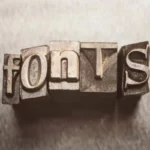- What Types of Fonts Exist?
- What Fonts Are Popular Today?
- Prayfair Display
- Bebas Neue
- Druk Wide
- Cinzel
- Gilroy
- Montserrat
- Proxima Nova
- PT Sans
- Work Sans
- Lato
- How to Choose the Winning Font Combination for a Specific Website?
- Conclusion
Fonts for a website are just as important design elements as shape, color, and other components. Properly selected typography for headers and basic text when filling a web resource with content makes reading information comfortable and easy. Additionally, the fonts used play a crucial role in creating an overall impression of a website, ultimately influencing the client’s decision whether to stay or leave the site.
Every designer faces the critical task of choosing a beautiful and suitable font during the development process of a website. To better understand how to accomplish this task, take the UX/UI training course from DevEducation, where professional instructors and IT specialists define all aspects of design creation. This article offers an overview of the top 10 popular and free fonts for commercial and non-commercial Internet resources.


What Types of Fonts Exist?
Before discussing the kinds of web fonts, we must explain choosing them correctly. According to research by the American company Nielsen Norman Group, published in 2020, internet users prefer to surf through the page first and then read the information more attentively and consciously. During the first web surf, users focus on different patterns but always pay attention to headings.
Typically, users browsing a website with a mobile device, prefer to read the text from start to finish. On the other hand, people who open a webpage on a PC or laptop often consume information in a highly condensed format through tables, diagrams, lists, and infographics. Regardless of the device used for surfing, what matters is that users only force themselves to decipher partially unreadable information.
This means that if a company or non-profit organization wants to capture the attention of its target audience, it’s crucial to carefully select fonts for its website’s design. Nowadays, web designers have an impressive variety of options when filling their clients’ web resources with content.
For example, fonts can be classified into two types based on their design approach: handwritten and printed. The first type has an original appearance and includes individualized subtypes, such as Cezanne, Picasso, and Kafka. Designers prefer them when they need to beautifully style headings and logos. However, using a handwritten variation for the main text is not recommended as it significantly hampers readability and comprehension.
Printed fonts are used for styling basic text. They can be divided into three subgroups:
- Sans-serif: These variations have a neutral character and do not have serifs. They are perfectly suitable for formatting key text, paragraphs, and headings.
- Serif: These typefaces significantly facilitate reading in printed publications because they visually separate the lines. In web design, these variations are not used to format the main body of information since they distract users and complicate perception. The primary purpose of serif is for logos and to present important information on web pages.
- Decorative: These variations have a vibrant, original, and expressive appearance. In most cases, these fonts are used for creating youth-oriented websites and web resources related to creativity and art. However, they should be used cautiously, as text formatted with decorative typefaces can be challenging for users. They are typically used for headlines and creating logos.
Modern web designers classify fonts into two subtypes: grotesque and antiqua. For example, typefaces with serifs fall under the antique category, while those without serifs, including handwritten ones, are considered weird. The optimal approach today is to combine fonts that harmoniously complement each other, creating an original design for the website.
What Fonts Are Popular Today?
Modern designers use the options collected in the Google Fonts database to create website designs. They can be downloaded for free and are known for their high quality and wide variety. Using them does not cause problems during the layout process, making them highly sought after.
Designers can easily integrate the Google Fonts library to access the necessary ones. For user convenience, Google Fonts provides various sorting methods. The library includes typefaces for Arabic, Hebrew, Latin, Cyrillic, and even hieroglyphic scripts. Users can find more suitable options through the filtering system and focus on the most popular tools by selecting the appropriate sorting.
We will now provide a more detailed overview of the top 10 most popular fonts actively used by web designers for styling commercial and non-commercial resources.

Prayfair Display
Replacing sharp feather quills with steel nibs significantly influenced typographic characters, making them less like handwriting ones. The active development of printing technology, paper production, and ink enabled the printing of characters with a high level of contrast and very thin lines.
Prayfair Display is an ideal choice for creating titles, such as news headlines. Developer Claus Sorensen offered web designers the opportunity to use it to make a stylistic effect for various headings and subheadings.
Bebas Neue
It is a free Sans Serif font invented by Japanese designer Ryoichi Tsunekawa. Bebas Neue is available in four modern variations:
- Thin
- Light
- Book
- Regular
Bebas Neue is excellent for creating subheadings, posters, navigation elements, and other components of a website.
Druk Wide
This font collection was introduced to the world in 2013. It was designed for the “about culture” category and gained popularity through its use in Bloomberg Businessweek – Etc. Druk Wide family pays tribute to Dutch designers who actively used bold and wide grotesque typefaces. These popular letterings were used to design catalogs dedicated to the Amsterdam City Museum.
Cinzel
The developers of this font were inspired by Roman symbolism from the first century. Cinzel features classical proportions and effectively combines the history of the entire Latin alphabet with modern art rather than simply imitating the Renaissance era.
Gilroy
Designers often choose versatile fonts that can adapt to any stylistic direction. Gilroy is one such option, belonging to the line of contemporary sans-serif typefaces with various geometric touches.
Gilroy is part of the Qanelas typeface family, created with powerful OpenType features. The font’s versatility is further enhanced by:
- its support for multiple languages (including Cyrillic)
- fractions
- table figures
- arrows
- ligatures, and many other elements.
Gilroy is used for graphic and editorial design, website design, advertising signage, and other purposes.
Montserrat
Designer Julieta Ulanovsky drew inspiration from old posters and signs in the Montserrat neighborhood of Buenos Aires. Monsterat is considered the perfection of urban typography that emerged in the 20th century.
The letters that inspired this project were filled with dedication, appropriate colors, and light. They were developed to preserve the valuable elements of Montserrat.
Proxima Nova
This font family is a complete overhaul of Proxima Sans, originally designed in 1994. Initially, there were only six variations, but today designers have access to forty-eight fully functional OpenType typefaces.
Web designers can choose from three widths in the collection:
- Regular
- Condensed
- Extra Condensed
Each width is represented by sixteen fonts (seven weights with corresponding italics).
Regarding its stylistic characteristics, Proxima Nova bridges the gap between Futura and contemporary sans-serif classics. Designers can reach a hybrid that combines humanistic proportions with slight geometric elements.
PT Sans
Many web designers use specialized font software to quickly create a unique website design. The PT Sans typeface family is popular due to its versatility. It includes eight styles: bold, regular, and their corresponding italics.
The design of PT Sans collection combines a classic conservative type with modern elements (a humanistic sans-serif). As a result, PT Sans offers a high level of readability. Besides its everyday use in various business programs and printed materials, this font is often used for creating signs, roadmaps, information kiosks, and other visual communication elements in cities.
Work Sans
This font library is based on early grotesque typefaces (Bauer Bodoni, Miller, Stevenson Blake). All variations are optimized for reading text on medium-sized displays. Work Sans is frequently used for print materials.
The Work Sans collection is specifically designed for use on the web, as it closely matches larger weights. The font’s functionality is simplified and adapted to the resolution of specific displays.
Lato
Developer Łukasz Dziedzic introduced his sans-serif typeface, Lato, in 2019. Within half a year, the typeface library was published under the OpenFont license with the support of Google.
Initially, the typefaces were intended for corporate use with large clients, but later the developer decided to abandon that and take a different direction. As a result, the Lato font family is now available for open use.
How to Choose the Winning Font Combination for a Specific Website?
Approximately 9 out of 10 users consciously do not pay attention to the fonts used in web design. However, if you ask such a person to describe a page with poorly matched typeface pairs or unreadable variations, they will recall their negative experience (unpleasant, difficult, or uninteresting). But the same text set in a more comfortable and fashionable font will be read with enthusiasm.
This means that for ordinary internet users, the perception of information is essential: the harmony of the overall website design, the readability of the text, and the proper placement of accents for orientation. Therefore, the main task of a specialist is to work on such factors and maintain a consistent thematic concept throughout the website.
Here are some secrets for selecting fonts for web design:
- Avoid using more than three typefaces in the design process. Using more fonts distracts potential customers, adds complexity, and slows down page loading. A one second fraction can play a negative role in shaping a user’s perception of a brand.
- Pay close attention to readability. If the text cannot be read, other design elements don’t matter. It’s important to offer users text that is so appealing that they won’t want to leave the website within the first few seconds. Ensure the content is easily read and the font parameters (color, size, weight, etc.) are properly selected.
- Use typography logically. It’s recommended to use different typeface combinations and font pairings. It’s important to follow the logic of the design, with headings being larger than subheadings, and the basic text should not merge with a colored background.
Furthermore, it’s recommended to carefully observe the compatibility of fonts and replace them if there are any doubts. Traditionally, serif and sans-serif variations are used, different typeface categories, and varying contrast between the main text and subheadings.
To evaluate the harmony of the design, you can use the “peripheral vision” technique — direct your gaze to the right or left of the textual content, which allows you to perceive the overall picture without reading the actual information. This method helps the designer determine whether the font is suitable for web design creation.
Conclusion
Today, many web designers choose free typefaces for websites because they are cost-effective and because of their versatility and readability on various screens. In this article, we have discussed the most popular and sought-after font families among IT specialists, which are available for public use without the need to purchase them. Choosing the right type font pairing will allow you to develop an attractive website that appeals to your business’s target audience.




